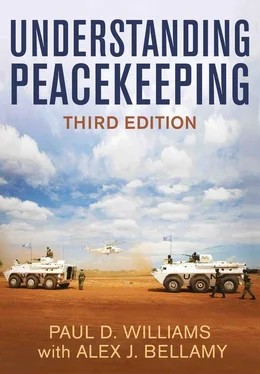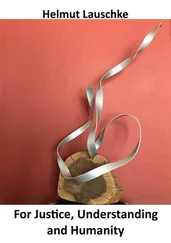The UN’s operation in the Congo (ONUC, 1960–4) was a larger, more complex, costly and multifaceted operation than anything the organization had attempted previously. Although largely successful in terms of accomplishing its mandate by helping to hold the country together, it proved highly controversial, divided the Security Council and assisted in creating a financial crisis for UN peace operations. At its height, almost 20,000 troops were deployed alongside a significant civilian component, and the mission was mandated to fulfil a number of different roles, including enforcement tasks and consolidating state authority (Abi-Saab 1978; James 1994). ONUC was mandated to maintain law and order during the Congo’s turbulent decolonization after Belgian rule. However, the rapid disintegration of the security situation forced it away from Hammarskjöld’s vision of preventive diplomacy (based on the same principles as UNEF I) and towards peace enforcement to help defend the Congo’s territorial integrity (Dayal 1976). In 1961, for example, UN forces conducted a large-scale offensive against Katanganese separatists and Western mercenaries (Operation Morthor). There were heavy casualties on both sides, but UN forces prevailed.
Table 3.2 UN-led peace operations, 1945–1987
| Mission |
Dates |
Purpose |
| UN Truce Supervision Organization (UNTSO) |
1948–present |
Monitor adherence to terms of General Armistice Agreement in Middle East |
| UN Military Observer Group in India and Pakistan (UNMOGIP) |
1949–present |
Monitor Indo-Pakistan ceasefire in Kashmir |
| UN Emergency Force I (UNEF I) |
1956–67 |
Buffer between Israel and Egypt in Sinai |
| UN Observation Group in Lebanon (UNOGIL) |
1958 |
Monitor arms and troop movements in Lebanon |
| UN Operation in the Congo (ONUC) |
1960–4 |
Restore order and assist Congolese government |
| UN Temporary Executive Authority (UNTEA) |
1962–3 |
Administer West New Guinea before transfer to Indonesian sovereignty |
| UN Yemen Observation Mission (UNYOM) |
1963–4 |
Monitor arms and troop movements into Yemen from Saudi Arabia |
| UN Force in Cyprus (UNFICYP) |
1964–present |
Maintain order before 1974 Turkish invasion; monitor buffer zone afterwards |
| UN India–Pakistan Observer Mission (UNIPOM) |
1965–6 |
Monitor ceasefire after 1965 India–Pakistan War |
| Mission of the Representative of the Secretary-General in the Dominican Republic (DOMREP) |
1965–6 |
Observe and report on breaches of the ceasefire in the Dominican Republic |
| UN Emergency Force II (UNEF II) |
1974–9 |
Act as a buffer between Israel and Egypt in the Sinai |
| UN Disengagement Observer Force (UNDOF) |
1974–present |
Monitor the separation of Israeli and Syrian forces on Golan Heights |
| UN Interim Force in Lebanon (UNIFIL) |
1978–present |
Buffer between Israel and Lebanon |
The political fallout from ONUC had a profoundly negative effect on UN peace operations. The Soviet Union and France in particular complained that it had exceeded its original mandate and that, having authorized the mission, the Security Council had little control over its direction. In particular, the Soviets condemned the American role in the ousting and assassination of Lumumba and the installation as president of Mobutu Sese Seko – an American ally, head of the army and, as it turned out, a corrupt tyrant. They argued that, in supporting Mobutu, ONUC was acting as a proxy for the US, not as an agent of the Security Council. In addition, they complained about the operation’s spiralling costs. In protest at both the direction and the cost of the mission, the Soviet Union and France withheld their peacekeeping dues. This caused an immediate funding crisis for UN operations and led to the adoption of a new financial system nearly a decade later.
More generally, France and the Soviet Union were sceptical of UN operations, seeing in them the danger of politicization that led the Soviets to reject the UN army concept in the 1940s. At French and Soviet insistence, several reforms were made to the way that UN peace operations were constituted and managed. Most significantly, operations would be mandated for only six months at a time. This gave the Security Council the opportunity to review individual operations and permanent members the chance to veto the continuation of operations. Although adding to the complexity of managing peace operations, this was a positive development which ensured that UN operations were doing the bidding of the organization as a whole, prevented future politicization, and gave the Security Council a permanent role in overseeing the missions it authorized. Second, the financial crisis sparked by ONUC led to the removal of peace operations expenses from the general UN budget and the creation of separate peacekeeping budgets (see chapter 2).
After ONUC, UN peace operations took something of a political battering and entered two decades of relative decline. When the 1967 war in the Middle East forced the collapse of UNEF I, the UN and its then Secretary-General, U Thant, were pilloried in the American and British press for failing to prevent the conflict by acceding to Egypt’s request to withdraw (Thakur 2006: 328). This was rather unfair, given UNEF’s mandate and the Security Council’s inability to reach a consensus on how to proceed, but it contributed to a general pessimistic attitude about the potential for peace operations to make a positive contribution to international peace and security (Urquhart 2007: 24). In the twenty-three years that followed ONUC, the UN took on only five new missions, four of which were continuations of previous UN engagements in the Middle East and Kashmir. The fifth, UNFICYP in Cyprus, was aided by a unique set of circumstances that saw Britain, which had assumed responsibility for security on the island, keen to divest itself of those responsibilities and spread the burden. Things got particularly bad in the 1970s and early 1980s, when a worsening of Cold War tensions reduced the level of consensus in the Security Council. Combined with the enduring financial crisis, this encouraged further retreat from peace operations, with only one new mission (UNIFIL in Lebanon) established between 1977 and 1987. This was also a particularly divisive era in the wider UN membership, with the General Assembly increasingly used to push the agenda of the post-colonial world, much of which had organized itself into the Non-Aligned Movement (NAM).
In 1971, the Security Council appointed Kurt Waldheim as Secretary-General, undeterred by the fact that he had failed in his bid to be elected president of Austria and that he had served as an officer in the German army during the Second World War. To rub salt into the wound, the Soviet Union vetoed the alternative candidate, the American Max Jakobsen, on the grounds that the Arab world would never accept a Jewish Secretary-General. The General Assembly followed suit by declaring ‘Zionism is racism’ and calling for a ‘New International Economic Order’, moves which helped further alienate the United States and other Western governments. To make matters worse, it later transpired that Waldheim had lied about his military career and had, in fact, been an SS officer and a willing volunteer for the Nazis. By 1980, the UN had almost become an irrelevance in the West (Traub 2006: 19–21; Urquhart 2007: 25–6). There was therefore little support for expanding the scope of its peace operations. And, as it turned out, UNIFIL revealed many of the problems that had prompted states to move away from using UN peace operations as a tool of preventive diplomacy. Financial shortfalls and the lack of consent from belligerents persuaded many member states that peace operations could function effectively only if all the conditions set at the time of UNEF I were in place (see chapter 7). It is not surprising that there was a general retreat from peace operations, given the deep divisions that wracked the world along these two axes: the USA vs. USSR and the West vs. the Non-Aligned Movement.
Читать дальше












